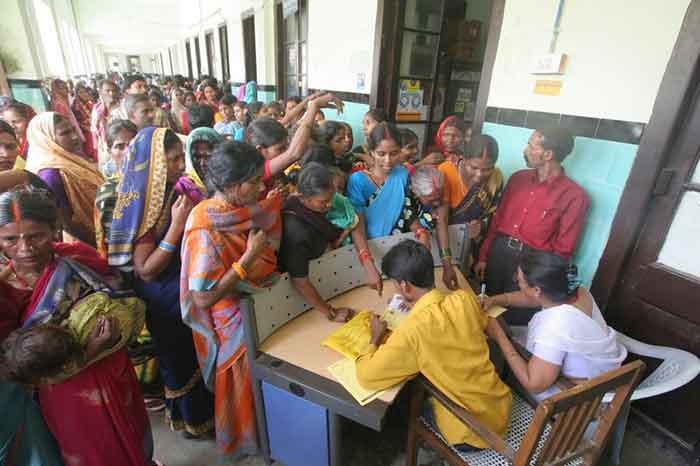The Indian healthcare system, once a beacon of hope rooted in ancient wisdom, has devolved into a "poor dream"—a fractured landscape where the poor are left to languish, burdened by inadequate facilities, unfulfilled political promises, and an over-reliance on costly private care.
From the Vedic Age, where humanity thrived without formal medicines through nature’s remedies, to the modern era’s shift to chemical compositions, India’s health narrative has undergone a profound transformation.
Today, an alarming 8 out of 10 Indians take medicines, often unnecessarily, reflecting a paradigm shift that has tethered lives to pharmaceutical dependency.
This blog post delves deeply into the historical evolution of healthcare in India, critiques the devastating impact of the political ecosystem on the healthcare infrastructure, explores the critical need for palliative care and support for the terminally ill, advocates for enhanced focus on mental health and physically disabled individuals with monetary and affordability measures, and examines the negligence stemming from the concurrent list division of health responsibilities between the center and states—despite it being a fundamental right. We’ll conclude with actionable insights to reclaim this dream for a healthier India.
From Vedic Wisdom to Chemical Dependency: The Evolution of Indian Healthcare
The Vedic Age: Survival Through Nature’s Medicines
In the Vedic Age (1500-500 BCE), India lacked formalized medical systems as we know them today. Yet, human survival persisted across millennia, sustained by nature’s bountiful remedies documented in texts like the Charaka Samhita and Sushruta Samhita. These ancient scriptures highlighted the use of herbs and natural substances—turmeric for its anti-inflammatory properties, neem for its antibacterial effects, ashwagandha for stress relief, and amla for immunity—alongside practices like yoga and meditation. Communities relied on local healers (vaidyas) who blended empirical knowledge with spiritual rituals, fostering a holistic approach to health. This reliance on nature, devoid of synthetic drugs, allowed populations to endure diseases, famines, and harsh climates, building resilience through a deep connection with the environment. Archaeological evidence from Harappan sites (circa 2600 BCE) suggests rudimentary dental care and herbal treatments, underscoring this survival mechanism.
The Modern Age Transition: From Nature to Chemicals
The advent of British colonial rule in the 18th century introduced allopathic medicine, marking a significant paradigm shift. Post-independence in 1947, India embraced this Western model, prioritizing chemical compositions over traditional systems.
The discovery of penicillin (1940s), the polio vaccine (1955), and the Green Revolution’s focus on synthetic fertilizers and medicines accelerated this transition. This shift enforced a new way of life, where health became synonymous with pharmaceutical intervention rather than prevention or natural balance.
By the late 20th century, India’s pharmaceutical industry boomed, becoming the world’s third-largest by volume (Indian Pharma Report, 2023), producing generics and over-the-counter drugs. However, this reliance has led to over-prescription; a 2022 study by the Indian Council of Medical Research (ICMR) revealed that 80% of Indians take medications, with 40% deemed unnecessary due to aggressive marketing by pharmaceutical companies, lack of public awareness, and a healthcare system incentivizing drug sales over holistic care. This dependency has shifted the focus from curing to managing chronic conditions, often at the expense of long-term well-being.
The Political Ecosystem’s Devastation of Indian Healthcare
India’s political landscape has systematically undermined the healthcare system through a litany of broken promises, leaving the poor in a state of despair:
1. Hollow Promises and Crumbling Infrastructure
Political parties have repeatedly pledged transformative healthcare reforms—free universal coverage, state-of-the-art hospitals, and accessible medicine—yet these remain unfulfilled dreams.
The National Health Policy (2017) aimed to raise public health spending to 2.5% of GDP by 2025, but it stagnates at 1.28% (Union Budget 2023-24), far below the global average of 6% (WHO, 2023). Public healthcare infrastructure is woefully inadequate, with only 1 hospital bed per 1,833 people compared to the WHO’s recommended 3.5 per 1,000. Rural health centers (PHCs) lack basic amenities—60% report no functional X-ray machines, 40% no reliable electricity, and 30% no clean water (Rural Health Statistics, 2022). Urban facilities fare slightly better, but overcrowding and poor sanitation render them ineffective, with 50% of patients reporting unhygienic conditions (Niti Aayog, 2022).
2. Acute Shortages of Doctors and Medicines
India faces a dire shortage of medical professionals, with a doctor-to-patient ratio of 1:1,457, well below the WHO’s 1:1,000 standard. Rural areas are hit hardest, with 70% of the country’s 1.2 million doctors concentrated in urban centers, leaving 65% of the population underserved. Specialist shortages are even more acute—only 1 cardiologist per 600,000 people and 1 oncologist per 1 million (Medical Council of India, 2023).
Medicine availability mirrors this crisis; 70% of essential drugs listed under the National List of Essential Medicines (NLEM) are out of stock in public facilities for over six months annually (WHO, 2023), forcing patients to procure them from private pharmacies at markups of 200-300% above government rates.
This scarcity drives a black market, with counterfeit drugs comprising 20% of the market (CDSCO, 2022), endangering lives.
3. Forced Reliance on Private Care and Financial Havoc
With public healthcare failing, 60% of Indians seek private treatment, where a single day’s hospitalization costs ₹5,000-₹20,000, compared to ₹500-₹1,000 in government hospitals (Niti Aayog, 2022).
For the poor, this translates to catastrophic expenditure—25% of rural households fall below the poverty line due to health costs (National Sample Survey, 2019), a figure rising to 40% in urban slums. Many incur debts, with 45% of low-income families reporting loans from moneylenders at 24-36% interest, while 30% sell assets like land or livestock. Credit issues compound this misery, with 20% facing legal action from creditors, perpetuating a cycle of poverty and despair that leaves families destitute and children out of school.
4. Violation of Fundamental Rights and Concurrent List Negligence
Health is enshrined as a fundamental right under Article 21 (right to life) and a directive principle under Article 47 (duty to improve public health) of the Indian Constitution. However, the concurrent list—where health responsibilities are shared between the central and state governments—has fostered a blame game of mutual inaction.
The center allocates only 1.28% of GDP, with states contributing a meager 0.5%, totaling 1.78% against the 5% needed for universal coverage (WHO, 2023).
Only 15% of National Health Mission (NHM) funds are released on time (2023 data), with states citing insufficient central grants, while the center blames state mismanagement. This neglect reflects a political focus on vote-bank schemes—free electricity or LPG connections—over health, with 70% of budgets diverted to visible projects (PRS Legislative Research, 2023).
Corruption further erodes funds, with 30% lost to mismanagement or scams (Transparency International, 2022), including the 2016 spurious drug racket that killed 32 patients. This systemic failure denies millions their constitutional right, highlighting a profound governance lapse.
Palliative Care: A Compassionate Necessity
Defining Palliative Care
Palliative care is a specialized approach to improve the quality of life for patients with life-limiting illnesses—such as advanced cancer, HIV/AIDS, or end-stage renal failure—through pain relief, symptom management, and psychological support. Unlike curative care, it embraces the inevitability of death, focusing on dignity, comfort, and family involvement.
In India, this care includes morphine for pain, counseling for emotional distress, and home-based support, tailored to cultural beliefs like last rites or family caregiving.
The Urgent Need for Government Focus
- Humanitarian Imperative: India records 1.5 million cancer deaths annually (WHO, 2023), with 70% of patients diagnosed at advanced stages, lacking access to pain relief—90% of whom receive no opioids due to regulatory barriers. Palliative care addresses this suffering, offering solace to 10 million needing it (Indian Association of Palliative Care, 2022).
- Demographic Pressure: With an aging population projected to reach 140 million by 2026, 60% of whom lack family support due to urbanization, end-of-life care is critical. Rural areas, home to 65% of seniors, see only 1% coverage.
- Economic Efficiency: Community-based palliative care costs ₹500-₹1,000 per patient monthly, compared to ₹10,000+ for hospital stays, reducing public health expenditure by 70-80% (Lancet, 2022).
Policy Recommendations and Monetary Support
- National Palliative Care Policy: Develop a policy integrating palliative care into primary healthcare, training 50,000 community health workers and 5,000 doctors by 2030, with rural focus. Establish 1,000 palliative care units nationwide.
- Monetary Assistance: Provide ₹5,000-₹10,000 monthly to palliative patients, covering medicines, home care, and lost income, as 75% deplete savings within six months of diagnosis (Lancet, 2022). Subsidize morphine and counseling, free at point of service.
- Rationale for Support: At life’s end, these patients cannot work, and families face emotional and financial strain. Government aid honors dignity, reduces poverty (25% of households affected), and aligns with Article 21, ensuring a humane exit.
Prioritizing Mental Health and Physical Disabilities
- Mental Health: India has 150 million mental health patients (WHO, 2023), including 50 million with depression and 30 million with anxiety, a 20% rise since 2015 due to urban stress, poverty, and digital overload. Yet, only 4,000 psychiatrists serve 1.4 billion people, with 70% in urban areas, leaving rural 65% underserved.
- Physical Disabilities: The 2011 Census reported 26 million disabled individuals (2.2% of population), with 60% facing mobility or visual impairments. Only 5% access government aid, while 80% lack accessible infrastructure—ramps, Braille signage—exacerbating isolation.
Policy and Support Measures
- Monetary Aid: Offer ₹3,000-₹5,000 monthly to disabled individuals, adjusted for inflation, and subsidize assistive devices—wheelchairs at ₹500 (vs. ₹10,000-₹20,000 market price), hearing aids at ₹1,000 (vs. ₹5,000).
- Affordability and Accessibility: Build 10,000 accessible public spaces (schools, buses) by 2030, train 20,000 caregivers, and integrate mental health into the National Mental Health Programme, adding 10,000 counselors.
- Rationale: These measures fulfill Article 41 (right to social security) and 47 (public health duty), reducing 40% poverty among disabled households (NSS, 2019) and improving quality of life. Mental health support tackles a 30% suicide rate linked to untreated conditions (NCRB, 2022).
The Concurrent List and Negligence: A Systemic Failure
Health falls under the concurrent list, allowing both center and states to legislate, yet this has led to mutual neglect.
The center sets policies and funds (1.28% GDP), while states implement, contributing 0.5%. However, coordination fails—only 15% of NHM funds are released on time (2023), with states receiving 85% of promised grants delayed (Ministry of Health, 2023). This reflects a lack of accountability, with neither level prioritizing health.
Reasons for Negligence
- Political Priorities: Governments favor populist schemes—free food grains (70% budget allocation) or housing—over health, with 70% of funds diverted to visible projects (PRS Legislative Research, 2023), neglecting rural 65% of the population.
- Corruption and Mismanagement: 30% of health funds are lost to corruption (Transparency International, 2022), including the 2016 spurious drug racket (32 deaths) and 2020 PPE kit scam (₹2,000 crore loss). Fake drug sales hit 20% of the market (CDSCO, 2022).
- Urban Bias: 80% of healthcare spending targets urban areas, where 35% of the population resides, leaving rural regions with 1 PHC per 30,000 people (vs. WHO’s 1:10,000).
- Lack of Political Will: Health’s low vote-bank appeal (unlike subsidies) leads to inaction, despite Article 21 and 47 mandates. Public protests (e.g., 2022 doctors’ strike) highlight this indifference.
This negligence violates constitutional rights, reflecting a systemic failure to value human life over political expediency.
Conclusion: Reclaiming the Dream Through Compassionate Reform
India’s healthcare system, once sustained by Vedic nature’s wisdom, has become a poor dream under the weight of political neglect, over-medication, and inadequate support for the vulnerable.
The transition from natural remedies to chemical dependency has left 80% of citizens medicating unnecessarily, while broken promises—lacking infrastructure, doctors, and medicines—drive the poor to private care, plunging them into debt and despair. Palliative care offers a humane solution for the terminally ill, mental health and disability support uplift millions, yet government inaction persists. Addressing the concurrent list’s failures, curbing corruption, and prioritizing health as a fundamental right are imperative. By enacting policies for palliative care (₹5,000-₹10,000 aid), mental health (10,000 counselors), and disabilities (accessible infrastructure), India can transform this dream into reality

 Sangram Keshari
Sangram Keshari









